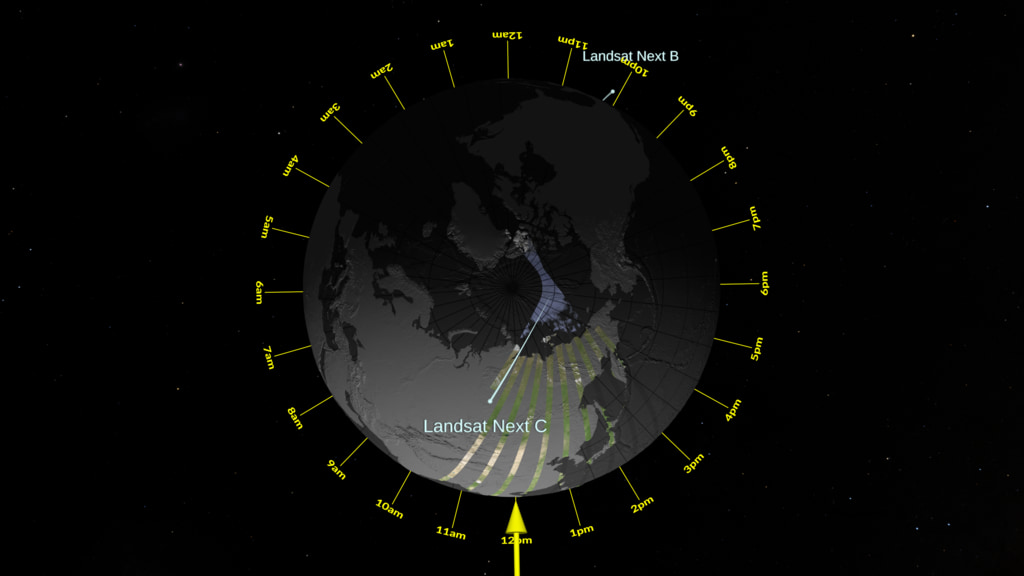Landsat Next Planned Orbits and Swath Coverage (version 2)
Lansdat Next trio of satellites orbiting and revealing data. It takes Landsat Next 6 days to get full coverage of the earth (aside from areas near the poles). This visualization shows two full cycles of coverage.
Landsat Next is the follow on mission to Landsat-9. Landsat Next which will provide data continuity to the decades long data record of the Earth’s land from space. It is still in the planning stages and is targeted for launch around 2030. Landsat Next is planned to have more than twice the number of bands as Landsat 8 and 9 and will consist of 3 separate spacecraft. This reduces amount of time needed for full Earth coverage to around 6 days.
These visualizations show example orbits and swaths of Landsat Next. The orbit swath widths shown are 164km wide. A visualization of Landsat 9 coverage is also included for comparison which is synchronized to the Landsat Next visualization.
The equatorial view shows the spacecraft orbits and swaths slowly appearing, revealing the colored Earth tiles. The orbits speed up showing the distances between orbits. The speed increases showing several days quickly. Finally, the orbits slow down as the last few orbits complete the full coverage of the Earth about 6 days from when it started. The cycle is repeated for another 6 days.
Landsat 9 coverage synchronized to the Landsat Next visualization for comparison.
Side-by-side comparison of Landsat-9 an Landsat-Next orbits and ground coverage
Credits
Please give credit for this item to:
NASA's Scientific Visualization Studio
-
Visualizer
-
Greg Shirah
(NASA/GSFC)
-
Greg Shirah
(NASA/GSFC)
-
Producer
- Chris Burns (KBR Wyle Services, LLC)
-
Project manager
- Jim Pontius (NASA)
-
Flight dynamics navigation engineer
- Donald Dichmann (NASA)
-
Technical support
- Laurence Schuler (ADNET Systems, Inc.)
- Ian Jones (ADNET Systems, Inc.)
Missions
This page is related to the following missions:Datasets used
-
GTOPO30 Topography and Bathymetry
ID: 274 -
BMNG (Blue Marble: Next Generation) [Terra and Aqua: MODIS]
ID: 508Credit: The Blue Marble data is courtesy of Reto Stockli (NASA/GSFC).
This dataset can be found at: http://earthobservatory.nasa.gov/Newsroom/BlueMarble/
See all pages that use this dataset -
Planning TLEs
ID: 1144 -
SVS Deep Star Maps 2020
ID: 1145Ernie Wright's star maps
Credit: Ernie Wright
This dataset can be found at: https://svs.gsfc.nasa.gov/4851
See all pages that use this dataset
Note: While we identify the data sets used on this page, we do not store any further details, nor the data sets themselves on our site.
Release date
This page was originally published on Wednesday, July 12, 2023.
This page was last updated on Sunday, October 6, 2024 at 11:20 PM EDT.
